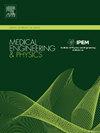Biomechanical evaluation for bone arthrosis morphology based on reconstructed dynamic kinesiology
IF 1.7
4区 医学
Q3 ENGINEERING, BIOMEDICAL
引用次数: 0
Abstract
A biomechanical evaluation method for bone arthrosis morphology based on reconstructed dynamic kinesiology (RDK) is proposed. The hip joint is a ball-and-socket joint, morphologically characterized by an acetabulum with a nearly spherical concavity and uniform curvatures, where Gaussian curvature exhibits negative characteristic. Subsequently, RDK of bone joint morphology is developed, offering detailed anatomical and kinematic insights. The hip joint is taken as a verification instance, where a precise biomechanical evaluation of bone arthrosis morphology is simulated through finite element analysis (FEA). Latin Hypercube sampling (LHS) with the criterion of maximizing the minimum distance enhances uniformity and representation. The response surface is subsequently constructed by Kriging interpolation, significantly enhancing computational efficiency and FEA accuracy. Innovatively, a stress contour statistical histogram of load transfer is presented to quantitatively analyze the stress lines, supplying support for biomechanical evaluation, which is essential for accurate hip replacement planning. The instance indicates that the proposed RDK facilitates accurate biomechanical evaluations for bone arthrosis morphology, providing a critical theoretical foundation for conceptual design of ergonomic wearable devices, as well as optimization of replacement surgeries.
基于重构动力学运动学的骨关节形态生物力学评价
提出了一种基于重构动态运动学(RDK)的骨关节形态生物力学评价方法。髋关节为球窝型关节,形态特征为髋臼近球形凹度和均匀曲率,其中高斯曲率表现为负特征。随后,开发了骨关节形态的RDK,提供了详细的解剖和运动学见解。以髋关节为验证实例,通过有限元分析(FEA)模拟骨关节形态的精确生物力学评价。以最小距离最大化为准则的拉丁超立方体采样(LHS)提高了均匀性和代表性。随后采用Kriging插值法构造响应面,显著提高了计算效率和有限元分析精度。创新性地提出了载荷传递的应力轮廓统计直方图,用于定量分析应力线,为生物力学评估提供支持,这对准确的髋关节置换术计划至关重要。实例表明,所提出的RDK有助于对骨关节形态进行准确的生物力学评估,为人体工程学可穿戴设备的概念设计以及置换手术的优化提供重要的理论基础。
本文章由计算机程序翻译,如有差异,请以英文原文为准。
求助全文
约1分钟内获得全文
求助全文
来源期刊

Medical Engineering & Physics
工程技术-工程:生物医学
CiteScore
4.30
自引率
4.50%
发文量
172
审稿时长
3.0 months
期刊介绍:
Medical Engineering & Physics provides a forum for the publication of the latest developments in biomedical engineering, and reflects the essential multidisciplinary nature of the subject. The journal publishes in-depth critical reviews, scientific papers and technical notes. Our focus encompasses the application of the basic principles of physics and engineering to the development of medical devices and technology, with the ultimate aim of producing improvements in the quality of health care.Topics covered include biomechanics, biomaterials, mechanobiology, rehabilitation engineering, biomedical signal processing and medical device development. Medical Engineering & Physics aims to keep both engineers and clinicians abreast of the latest applications of technology to health care.
 求助内容:
求助内容: 应助结果提醒方式:
应助结果提醒方式:


